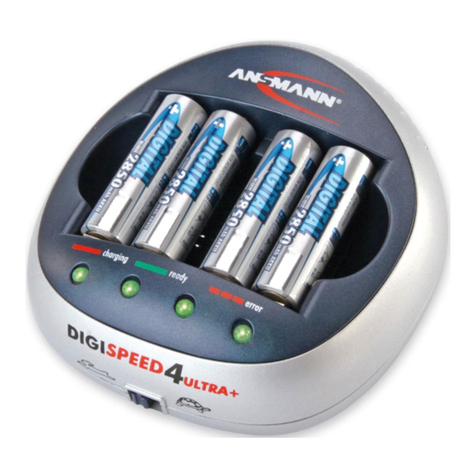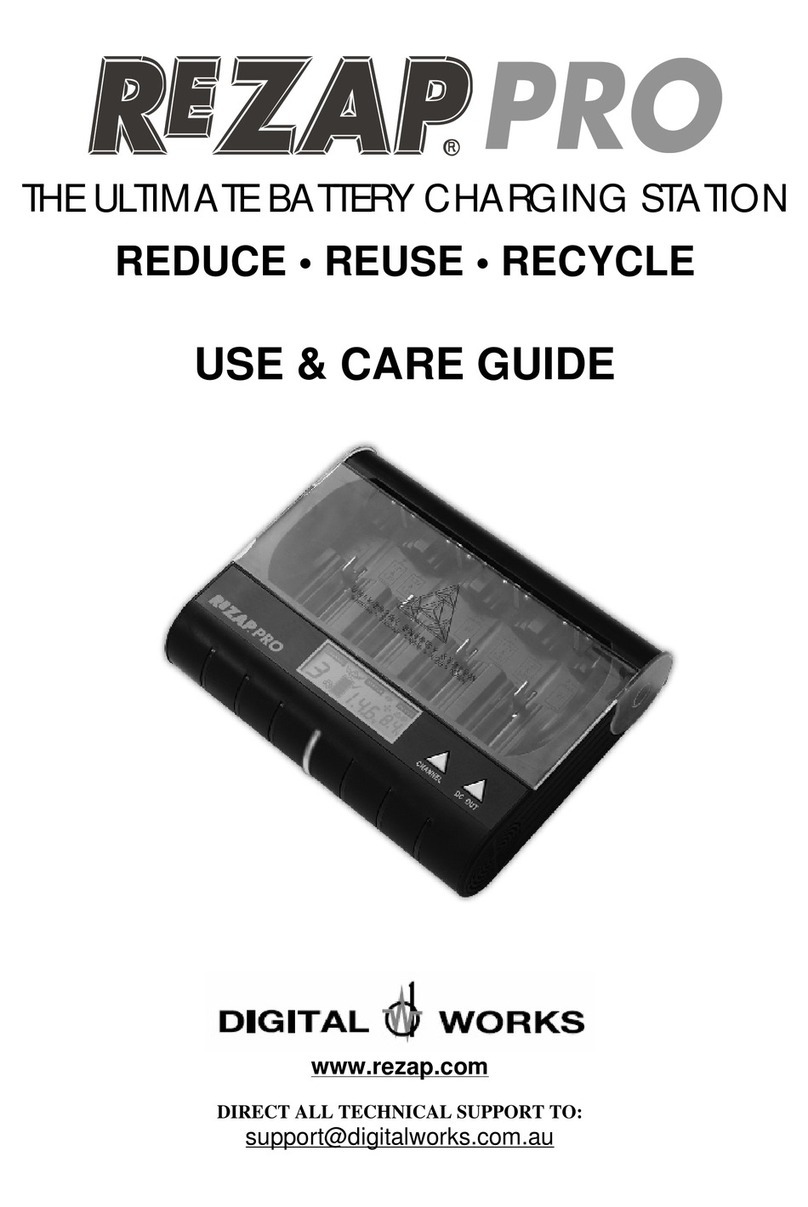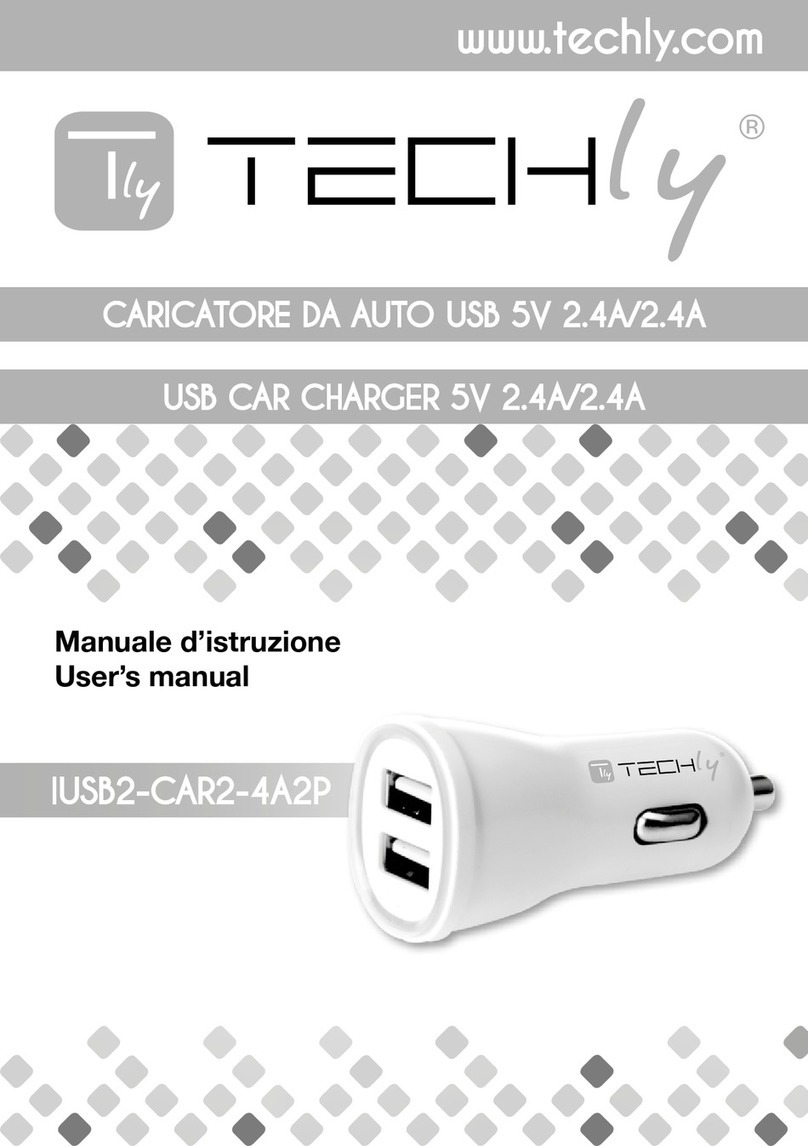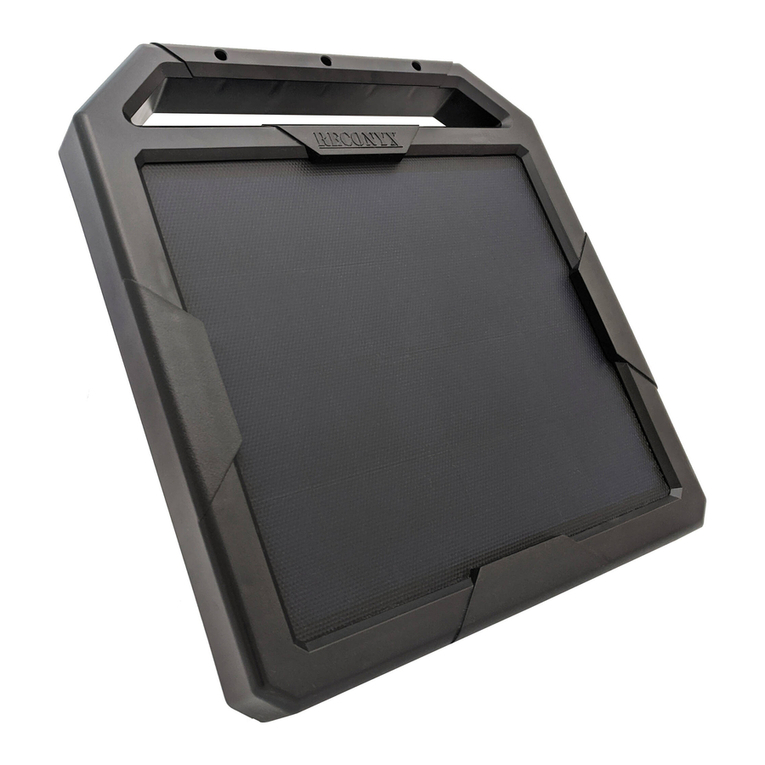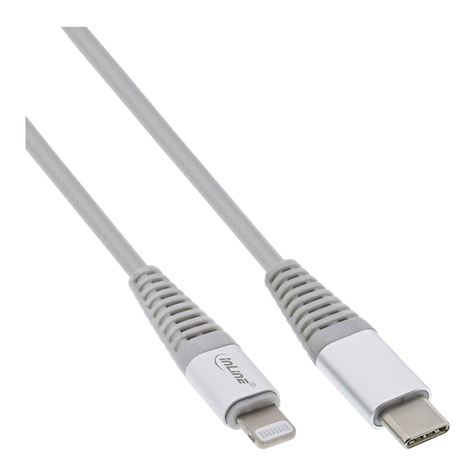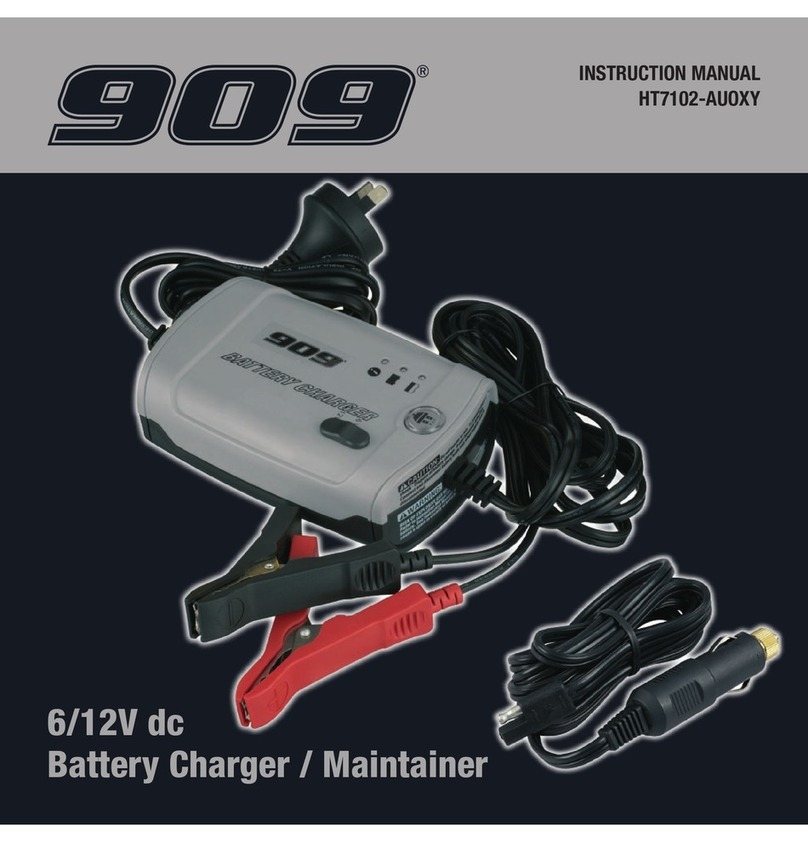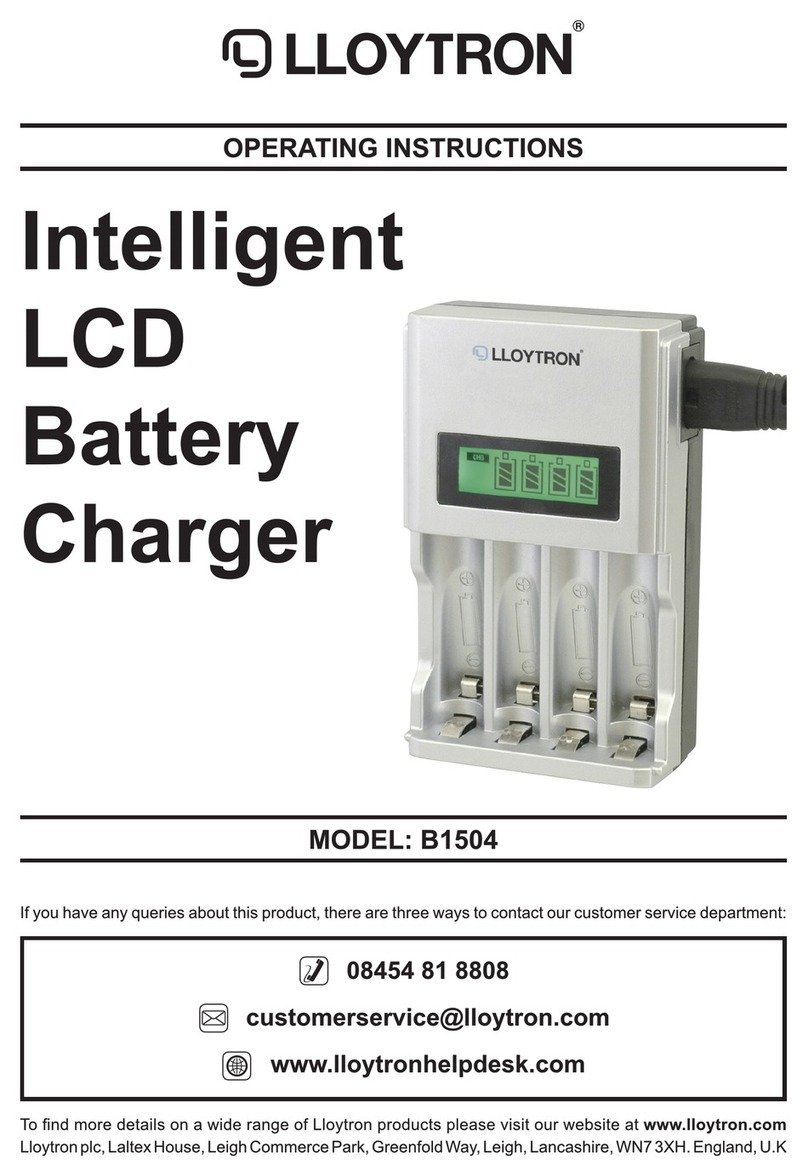Battery Doctor 20093 User manual

IMPORTANT SAFETY INSTRUCTIONS • SAVE THESE INSTRUCTIONS
WIRTHCO ENGINEERING, INC. • MINNEAPOLIS, MN 55439
© 2014 All rights reserved
Problem Possible Cause Reason/Solution
The charger is making an audible
clicking sound.
Circuit breaker is cycling. The settings may be wrong. Check the charger settings.
Battery is defective. Have the battery checked.
Shorted battery cables or clips. Circuit breaker cycles when current draw is too high. Check for shorted cables or clips
and replace if necessary.
Severely discharged batter, but
otherwise it is a good battery.
The battery may not want to accept a charge due to a run-down state. Allow charging
to continue until battery has a chance to recover sufficiently to take a charge. If more
than 20 minute, stop charging and have the battery checked.
Reverse connections at battery. Shut the charger off and correct the lead connections.
Charger makes a loud buzz
or hum.
Transformer laminations vibrate (buzz). No problem, this is a normal condition.
Shorted diode assembly of output
rectifier assembly (hum).
Have charger checked by a qualified service technician.
Short or no start cycle when
cranking engine.
Drawing more than the Engine Start
Rate.
Crank time varies with the amount of current drawn.. If cranking draws more than
the Engine Start Rate, crank time may be less than 3 seconds.
Failure to wait 4 minutes between
cranks.
Wait 4 minutes of rest time before the next crank to allow the battery and charger
to cool down.
Clips are not making a good connection. Check for poor connection at battery and frame.
AC cord and/or extension cord is loose. Check power cord and extension cord for loose fitting plug.
No power at receptacle. Check for open fuse or circuit breaker supplying AC outlet.
The charger may be overheated. The thermal protector may have tripped and needs a little longer to close. Make sure
the charger vents are not blocked. Wait and try again.
Battery may be severely discharged. On a severely discharged battery, charge for 10 to 15 minutes in the highest manual
rate to help assist in cranking.
15. BEFORE RETURNING FOR REPAIRS
15.1 When a charging problem arises, make certain that the battery is capable of accepting a normal charge. Be sure to double check all connec-
tions, AC outlet for power, charger clips or ring terminals are clean and for proper polarity.
15.2 When a battery is very cold, partially charged or sulfated, it will not draw the full rated amperes from the charger. It is both dangerous and
damaging to a battery to force higher amperage into it than it can effectively use.
16. LIMITED WARRANTY
WIRTHCO ENGINEERING, INC., MINNEAPOLIS, MN 55439 MAKES THIS LIMITED WARRANTY TO THE ORIGINAL PURCHASER AT RETAIL OF THIS PRODUCT. THIS
LIMITED WARRANTY IS NOT TRANSFERABLE.
WirthCo Engineering, Inc. has a limited warranty for this battery charger for five years from date of purchase at retail against defective material or
workmanship. If such should occur, the unit will be repaired or replaced at the option of the manufacturer. It is the obligation of the purchaser to
forward the unit together with proof of purchase, transportation and/or mailing charges prepaid to the manufacturer or its authorized representative.
• This limited warranty is void if the product is misused, subjected to careless handling, or repaired by anyone other than the manufacturer or its
authorized representative.
• The manufacturer makes no warranty other than this limited warranty and expressly excludes any implied warranty including any warranty for
consequential damages.
• This is the only express limited warranty and the manufacturer neither assumes nor authorizes anyone to assume or make any other obligation
towards the product other than this express limited waranty. The manufacturer makes no warranty of merchantability or fitness for purpose of this
product and expressly excludes such from this limited warranty.
• Some states do not allow the exclusion or limitation of incidental or consequential damages or length of implied warranty so the above limitations
or exclusions may not apply to you.
• This warranty gives you specific legal rights and you may also have other rights which vary from state to state.
IMPORTANT SAFETY INSTRUCTIONS • SAVE THESE INSTRUCTIONS
WIRTHCO ENGINEERING, INC. • MINNEAPOLIS, MN 55439
© 2014 All rights reserved
OWNER’S MANUAL (MODEL #20093)
2/10/55 AMP Battery Charger & Maintainer Instructions for 6 & 12 Volt Batteries
Read Instructions Carefully for Safe Operation
READ THE ENTIRE MANUAL BEFORE USING THIS PRODUCT.
FAILURE TO DO SO CAN RESULT IN SERIOUS INJURY OR DEATH.
WORKING IN VICINITY OF A LEAD-ACID BATTERY IS DANGEROUS. BATTERIES GENERATE EXPLOSIVE
GASES DURING NORMAL BATTERY OPERATION. FOR THIS REASON, IT IS OF UTMOST IMPORTANCE
THAT EACH TIME BEFORE USING THE CHARGER, READ THIS MANUAL AND FOLLOW
THE INSTRUCTIONS EXACTLY.
This manual will show how to use the charger safely and effectively. Please read, understand and follow these instructions and precautions carefully, as
this manual contains important safety and operating instructions. The safety messages used throughout this manual contain a signal word, a message
and an icon.
The signal word indicates the level of the hazard in a situation.
indicates an imminently hazardous situation which, if not avoided, will result in death or serious injury to the operator or bystanders.
indicates a potentially hazardous situation which, if not avoided, could result in death or serious injury to the operator or bystanders.
indicates a potentially hazardous situation which, if not avoided, could result in moderate or minor injury to the operator or bystanders.
indicates a potentially hazardous situation which, if not avoided, could result in damage to the equipment or vehicle or
property damage.
Safety messages in this manual contain two different type styles.
• Unnumbered type states the hazard
• Numbered type states how to avoid the hazard.
The icon gives a graphical description of the potential hazard.
Pursuant to California Proposition 65, this product contains chemicals known to the state of California to cause cancer and
birth defects or other reproductive harm.
1. IMPORTANT SAFETY INSTRUCTIONS
Risk of electric shock or fire.
1.1 Do not expose the charger to rain or snow.
1.2 Use only recommended attachments. Use of an attachment not recommended by WirthCo Engineering, Inc. may result in a risk of fire, electric
shock or injury to persons or damage to property.
1.3 To reduce the risk of damage to the electric plug or cord, pull by the plug rather than by the cord when disconnecting the charger.
1.4 An extension cord should not be used unless absolutely necessary. Use of an improper extension cord could result in the risk of fire and electric

shock. If an extension cord must be used, make sure:
• That the pins on the plug of the extension cord are the same number, size and shape as those of the plug on the charger
• That the extension cord is properly wired and in good electrical condition
• That the wire size is large enough for the AC ampere rating of the charger as specified in the table in Section 8
1.5 To reduce the risk of electrical shock, unplug the charger from the outlet before attempting any maintenance or cleaning.
1.6 Remove personal metal items such as rings, bracelets, necklaces and watches when working with a lead-acid battery. A lead-acid battery can
produce a short circuit current high enough to weld a ring or the like to metal, causing a severe burn.
1.7 Do not operate the charger with a damaged cord or plug; take it to a qualified service person.
1.8 Do not operate the charger if it has received a sharp blow, been dropped or otherwise damaged in any way; take it to a qualified service person.
1.9 Do not disassemble the charger; take it to a qualified service person when service or repair is required. Incorrect reassembly may result in a risk
of fire or electric shock.
2. PERSONAL PRECAUTIONS
Risk of explosive gases
2.1 Working in the vicinity of a lead-acid battery is dangerous. Batteries generate explosive gases during normal battery operation. For this reason,
it is of utmost importance to follow the instructions each time the charger is used.
2.2 To reduce the risk of a battery explosion, follow these instructions and those published by the battery manufacturer and the manufacturer of
any equipment used in the vicinity of the battery. Review the cautionary markings on these products and on the engine.
2.3 This charger employs parts, such as switches and circuit breakers, that tend to produce arcs and sparks. If used in a garage, locate this charger
18 inches or more above floor level.
2.4 NEVER smoke or allow a spark or flame in the vicinity of a battery or engine.
2.5 Be extra cautious to reduce the risk of dropping a metal tool onto the battery. It might spark or short-circuit the battery or other electrical part
that may cause an explosion.
2.6 Use this charger for charging LEAD-ACID batteries only. It is not intended to supply power to a low voltage electrical system other than in a
starter-motor application. Do not use this battery charger for charging dry-cell batteries that are commonly used with home appliances. These
batteries may burst and cause injury to persons and damage to property.
2.7 NEVER charge a frozen battery.
2.8 NEVER overcharge a battery.
3. PREPARING TO CHARGE
Risk of contact with battery acid. Battery acid is a highly corrosive sulfuric acid.
3.1 Consider having someone close enough by to come to help in case of an accident when working near a lead-acid battery.
3.2 Have plenty of fresh water and soap nearby in case battery acid contacts the skin, clothing or eyes.
3.3 Wear complete eye and body protection, including safety goggles and protective clothing. Avoid touching the eyes while working near the
battery.
3.4 If battery acid contacts the skin or clothing, immediately wash the area with soap and water. If acid enters the eyes, immediately flood the
eyes with cold running water for at least 10 minutes and get medical attention right away.
3.5 If it is necessary to remove the battery from the vehicle to charge it, always remove the grounded terminal first. Make sure all of the accessories
in the vehicle are off to prevent arcing.
3.6 Be sure the area around the battery is well ventilated while the battery is being charged.
3.7 Clean the battery terminals before charging the battery. During cleaning, keep airborne corrosion from coming into contact with the eyes, nose
and mouth. Use baking soda and water to neutralize the battery acid and help eliminate airborne corrosion. Do not touch the eyes, nose or
mouth.
3.8 Add distilled water to each cell until the battery acid reaches the level specified by the battery manufacturer. Do not overfill. For a battery
without removable cell caps, such as valve regulated lead-acid batteries (VRLA), carefully follow the manufacturer’s recharging instructions.
3.9 Read, understand and follow all instructions for the charger, battery, vehicle and any equipment used near the battery and charger. Study all of
the battery manufacturer’s specific precautions while charging and recommended rates of charge.
3.10 Determine the voltage of the battery by referring to the vehicle owner’s manual and make sure that the output voltage selector switch is set to
the correct voltage.
Battery Size/Rating Charge Rate/Charging Time
2 Amp 10 Amp
Small Batteries (6 Volt) Motorcycle, Garden,
Tractor, Etc.
6 - 12 AH ½- ¾hr
12 - 32 AH ¾- 2 hrs
Cars/Trucks (12 Volt)
200 - 315 CCA 40 - 60 RC 11¼ - 14½ hrs 2.14 - 3 hrs
315 - 550 CCA 60 - 85 RC 14½ - 18¼ hrs 3 - 3¾ hrs
550 - 1000 CCA 80 - 190 RC 18¼ - 34¾ hrs 3¾ - 7 hrs
Marine/Deep Cycle (12 Volt)
80 RC 17½ hrs 3½ hrs
140 RC 27 hrs 5½ hrs
160 RC 30 hrs 6 hrs
180 RC 33 hrs 6¾ hrs
12. MAINTENANCE INSTRUCTIONS
This charger requires minimal maintenance. As with any appliance or tool, a few common sense rules will prolong the life of the battery charger.
ALWAYS BE SURE THE CHARGER IS UNPLUGGED BEFORE PERFORMING ANY MAINTENANCE OR CLEANING.
12.1 Store in a clean, dry place
12.2 Coil up the cords when not in use.
12.3 Clean the case and cords with a slightly damp cloth.
12.4 Clean any corrosion from the clamps with a solution of water and baking soda.
12.5 Examine the cords periodically for cracking or other damage and have them replaced if necessary.
All other service should be done by qualified personnel only.
13. STORAGE INSTRUCTIONS
13.1 Store the charger unplugged. The cord will still conduct electricity until it is unplugged from the outlet.
13.2 Store inside, in cool, dry place.
13.3 Do not store the clips on the handle, clipped together, on or around metal or clipped to cables.
14. TROUBLESHOOTING
Problem Possible Cause Reason/Solution
No reading on the Digital Meter. Charger is not plugged in. Plug the charger into an AC outlet.
No power at the receptacle. Check for open fuse or circuit breaker supplying AC outlet.
Clips are not making a good connection
to the battery.
Check for poor connection to battery and frame. Make sure connection points are
clean. Rock clips back and forth for a better connection.
Connections are reversed. Unplug the charger and revers the clips.
Battery is defective (will not accept
a charge).
Have battery checked.
Charger will not turn on when
properly connected.
AC outlet is dead. Check for open fuse or circuit breaker supplying AC outlet.
Poor electrical connection. Check power cord and extension cord for loose fitting plug.
The battery is connected and the
charger is on, but is not charging.
Clips are not making a good connection. Check for poor connections at battery and frame. Make sure connecting points are
clean. Rock clips back and forth for a better connection.
The measured current is much
lower than what was selected.
The charger reached the maximum
voltage and is reducing the current.
No problem, this is a normal condition.
Meter reads less than selected
charge rate when charging a
discharged battery.
Extension cord is too long or wire gauge
is too small.
Use a shorter or heavier gauge extension cord.
Weak cell or sulfated plate in battery. A sulfated battery will eventually take a normal charge if left connected. If the
battery will not take a charge have it checked.
Battery is only partially discharged. Continue to charge the battery.

Charging Current (Amp) — Use this selection to display the current drawn from the charger on the LED digital display when charging. The display
will revert back to battery voltage within 5 seconds.
10.3 CHARGING:
• Connect the charger to battery per instructions in section 6.
• Connect the charger to AC outlet.
• Set the SELECT FUNCTION to CHARGE.
• Set the SELECT SETTING to the appropriate charge current rate. For 12V batteries, there is a choice between 10 Amp and 2 Amp charging
rate. When the 12V/10 Amp mode is used, the charger will automatically turn off once the battery reaches 14.6VDC.
The charger will not shut off automatically on the 12V/2 Amp or 6V/10 Amp settings. DO NOT LEAVE THE BATTERY
UNATTENDED OR IT COULD EXPLODE CAUSING PROPERTY DAMAGE OR PERSONAL INJURY.
• When disconnecting the charger, always unplug the unit from the wall first. Disconnect the NEGATIVE (NEG, N, -) connection, then remove
the POSITIVE (POS, P, +) connection in this sequence.
10.4 AUTOMATIC On-off Circuit:
With charger in automatic shut-off mode (12V/10 Amp), charger DC output will shut off when the correct voltage is reached (14.6V). Monitor
charging daily to ensure that the battery does not overcharge and battery electrolyte is correct. When the charger DC output does shut off, the
green “Charge Complete LED” will come on. Power is still supplied to the charger transformer, so a slight hum or buzzing sound is normal as the
charger continues to monitor the battery charge level. If the “Charge Complete LED” does not come on at least once in a full day of charging,
set the SELECT FUNCTION switch to START. If the “Charge Complete LED” does not come on within 30 minutes, discontinue charging and have
the battery tested.
10.5 BOOST STARTING:
• Turn off all lights and accessories in the stalled vehicle.
• Connect the charger to battery per instructions in sections 6 or 7.
• Connect the charger to AC outlet.
• Set the SELECT FUNCTION switch to START.
• Set the SELECT SETTING to the 55A START.
• Charge the battery for at least five minutes before attempting to start the vehicle.
• Start the vehicle with the charger connected to the battery.
Do not crank the engine more than 5 seconds in any four minute period; excessive cranking may overheat and damage the
starter. If the vehicle fails to start, while waiting for the starter to cool, allow the charger to continue to charge the battery. Unplug the charger before
disconnecting DC clips from battery.
10.6 AUTOMATIC RESET CIRCUIT BREAKER:
The battery charger has been equipped with an automatic reset circuit breaker. This protects the charger from temporary overload conditions.
A severely discharged battery, a battery with shorted cells, or reversed charger connections at the battery will cause this protective device to
operate. Under these overload conditions, the circuit breaker will open, and when cooled down will reset automatically. This cycling process can
be identified by a clicking sound made during the opening and closing of the circuit breaker.
Follow all safety instructions and precautions for charging the battery. Wear complete eye protection and clothing
protection. Charge the battery in a well-ventilated area.
Using the ENGINE START feature WITHOUT a battery installed in the vehicle could cause damage to the vehicle’s electrical system.
NOTE: During extremely cold weather, or if the battery is under 2 volts, charge the battery for 5 minutes before cranking the engine. If the engine fails
to start, charge the battery for 5 more minutes before attempting to crank the engine again. After the engine starts, move the amp rate selector switch
to the “off” position and unplug the AC power cord before disconnecting the battery clips from the vehicle.
NOTE: If the engine does turn over but never starts, there is not a problem with the starting system; there is a problem somewhere else with the
vehicle. STOP cranking the engine until the other problem has been diagnosed and corrected.
10.7 USB:
• The USB outlet will provide up to 2.1A at 5VDC to portable devices.
• Supplied with the charger is a LED work light. To use the LED work light, plug into the USB outlet.
11. CALCULATING CHARGE TIME
• Use the following table to more accurately determine the time it will take to bring a battery to full charge. First, identify where the battery fits into
the chart.
• Find the battery’s rating on the chart below and note the charge time given for each charger setting. The times given are for batteries with a 50%
charge prior to recharging. Add more time for severely discharged batteries.
4. CHARGER LOCATION
Risk of explosion and contact with battery acid.
4.1 Locate the charger as far away from the battery as the DC cables permit.
4.2 Never place the charger directly above the battery being charged: gases from the battery will corrode and damage the charger.
4.3 Do not set the battery on top of the charger.
4.4 Never allow battery acid to drip onto the charger when reading the electrolyte specific gravity or filling the battery.
4.5 Do not operate the charger in a closed-in area or restrict the ventilation in any way.
5. DC CONNECTION PRECAUTIONS
5.1 Connect and disconnect the DC output clips only after removing the AC plug from the electrical outlet. Never allow the clips to touch each other.
5.2 Attach the alligator clips to the battery. It is recommended to twist or rock the alligator clips back and forth several times to make a good
connection. This tends to keep the alligator clips from slipping off the battery terminals and helps reduce the risk of sparking.
6. FOLLOW THESE STEPS WHEN BATTERY IS INSTALLED IN VEHICLE
A spark near the battery may cause a battery explosion. To
reduce the risk of a spark near the battery:
6.1 Position the AC and DC cables to reduce the risk of damage by the hood, door, moving or hot engine parts.
NOTE: If it is necessary to close the hood during the charging process, ensure that the hood does not touch the metal part of the battery clips or
cut the insulation of the cables.
6.2 Stay clear of fan blades, belts, pulleys and other parts that can cause injury.
6.3 Check the polarity of the battery posts. The POSITIVE (POS, P, +) battery post usually has a larger diameter than the NEGATIVE (NEG, N, -)
post.
6.4 Connect the POSITIVE (RED) clip from the battery charger to the POSITIVE (POS, P, +) ungrounded post of the battery. Connect the NEGATIVE
(BLACK) clip to the vehicle chassis or engine block away from the battery. Do not connect the clip to the carburetor, fuel lines or sheet-metal
body parts. Connect to a heavy gauge metal part of the frame or engine block.
6.5 When disconnecting the charger, disconnect the AC cord from the wall. Next remove the NEGATIVE (NEG, N, -) from the chassis ground first,
then remove the POSITIVE (POS, P, +) clip from the battery terminal.
6.6 See CALCULATING CHARGE TIME for length of charge information in section 11.
7. FOLLOW THESE STEPS WHEN BATTERY IS OUTSIDE VEHICLE.
A spark near the battery may cause a battery explosion. To
reduce the risk of a spark near the battery:
7.1 Check the polarity of the battery posts. The POSITIVE (POS, P, +) battery post usually has a larger diameter then the NEGATIVE (NEG, N, -)
post.
7.2 Attach at least a 24-inch (61 cm) long 6-gauge (AWG) insulated battery cable to the NEGATIVE (NEG, N, -) battery post.
7.3 Connect the POSITIVE (RED) charger clip to the POSITIVE (POS, P, +) post of the battery.
7.4 Position yourself and the free end of the cable previously attached to the NEGATIVE (NEG, N, -) battery post as far away from the battery as
possible – then connect the NEGATIVE (BLACK) charger clip to the free end of the cable.
7.5 Do not face the battery when making the final connection.
7.6 When disconnecting the charger, always unplug the unit from the wall first. Disconnect the NEGATIVE (NEG, N, -) connection, then remove the
POSITIVE (POS, P, +) connection in this sequence.
7.7 A marine (boat) battery must be removed and charged on shore.

8. BATTERY CHARGING - AC CONNECTIONS
Risk of electric shock or fire.
8.1 This battery charger is for use on a nominal 120-volt circuit and has a grounded plug that looks like the plug illustrated. The charger must be
grounded to reduce the risk of electric shock. The plug must be plugged into an outlet that is properly installed and grounded in accordance with
all local codes and ordinances. The plug pins must fit the receptacle (outlet). Do not use with an ungrounded system.
8.2 Never alter the AC cord or plug provided – if it does not fit the outlet, have a proper grounded outlet installed by a qualified electrician. An
improper connection can result in a risk of electric shock or electrocution.
NOTE: The use of an adapter plug is not recommended.
g
DANGER. Before using adapter as illustrated, be certain that center screw of outlet plate is grounded. The green-colored rigid ear or lug
extending from the adapter must be connected to a properly grounded outlet - make certain it is grounded. If necessary, replace original outlet
cover plate screw with a longer screw that will secure adapter ear or lug to outlet cover plate and make ground connection to grounded outlet.
NOTE: USE OF AN ADAPTER IS NOT ALLOWED IN CANADA. IF A GROUNDING TYPE RECEPTACLE IS NOT AVAILABLE, DO NOT USE THIS APPLIANCE
UNTIL THE PROPER OUTLET IS INSTALLED BY A QUALIFIED ELECTRICIAN.
8.3 Recommended minimum AWG size for extension cord:
AC input rating, amperes* AWG size of cord
Length of cord feet (m)
At least But less than 25 (7.6) 50 (15.2) 100 (30.5) 150 (45.6)
0 2 18 18 18 16
2 3 18 18 16 14
3 4 18 18 16 14
4 5 18 18 14 12
5 6 18 16 14 12
6818161210
81018141210
10 12 16 14 10 8
12 14 16 12 10 8
14 16 16 12 10 8
16 18 14 12 8 6
18 20 14 12 8 6
*If the input rating of a charger is given in watts rather than in amperes, the corresponding ampere rating is to be determined by dividing
the wattage rating by the voltage rating - for example: 1200 watts/120 volts = 10 amperes
9. FEATURES
VOLT
AMP
DISPLAY
MODE
REVERSE
CONNECTION
CHARGE
COMPLETE USB PORT CHARGE
START 12V
10A 2A
12V
55A
10A
6V
AUTOMATIC MANUAL
2/10/55 AMP
6V/12V BATTERY CHARGER
WITH ENGINE START
10. OPERATING INSTRUCTIONS
Before using review all safety and connection directions before using charger. Failure to do so can
damage battery and cause serious injury or death.
10.1 SELECT SETTING switch use:
55A START — Use this setting for starting a 12V vehicle with a discharged battery.
10A–12V — Use this setting for charging large 12 volt batteries. This setting will shut the charger off once the battery is charged.
2A–12V — Use this setting for charging small 12 volt batteries such as lawn mowers, tractors, motorcycles, etc.
(Monitor battery continually, since this rating does not taper or shut off automatically.)
10A–6V — Use this setting for charging 6 volt batteries.
(Monitor battery continually, since this rating does not taper or shut off automatically.)
NOTE: Unless the information is supplied for the particular battery, always charge small 12 Volt batteries at no more than 2 Amps.
10.2 SELECT DISPLAY switch use:
Battery Voltage (Volt) — Use this selection to display the battery’s voltage on the LED digital display.
1. Digital LED Display
2. Reverse Polarity Warning LED
3. Charge Complete LED
4. USB Accessory Port
5. Charge/Start Switch
6. Amperage Select Switch
7. Display Volt/Amp Switch
8. Alligator Clips
9. USB LED Light
1
2
7
3456
9
8
Other Battery Doctor Batteries Charger manuals
Popular Batteries Charger manuals by other brands
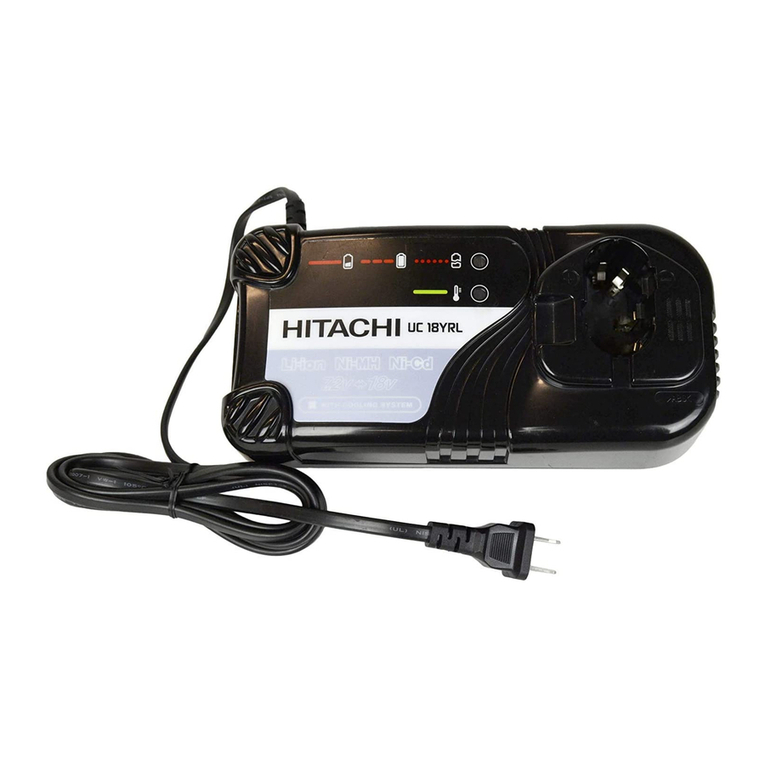
Hitachi
Hitachi UC 18YFL Safety and instruction manual

Siemens
Siemens VersiCharge Ultra 175 Site Installation Manual

Sony
Sony MPA-BT1A operating instructions

YATO
YATO YT-85132 Operating instruction
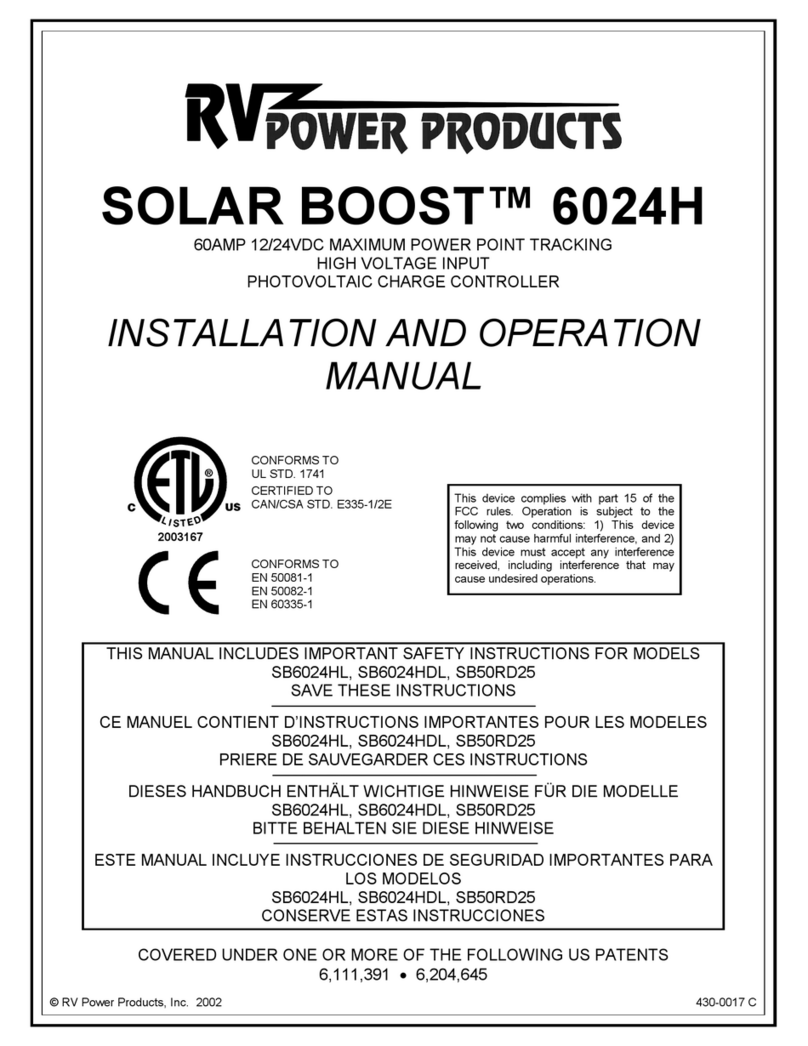
RV Products
RV Products SB6024HL Installation and operation manual
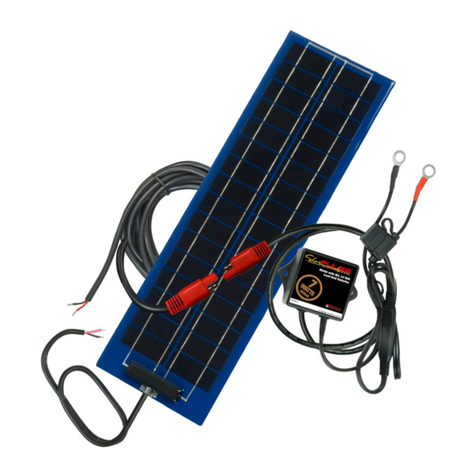
PulseTech
PulseTech 12V ERV UNIT installation manual





